Integrated Emergency Management: UK Incidents and Recovery Analysis
VerifiedAdded on 2020/10/05
|12
|3171
|87
Report
AI Summary
This report provides a detailed overview of integrated emergency management, focusing on the principles of effective emergency response, various recovery stages, and the importance of debriefing for future planning. It examines the Civil Contingency Act of 2004 and the role of public services, including the police, fire brigade, and healthcare services, in managing incidents. The report highlights the four phases of emergency management: mitigation, preparedness, response, and recovery. It then discusses key principles like the Strategic Coordinating Group (SCG) and media communication. The report further explores recovery stages, including rebuilding, restoring, rehabilitating, and humanitarian aid, and the role of financial resources and local authorities. The report also provides real-world examples of emergency incidents, such as the Parson's Green train bombing in the UK. The report also highlights the importance of debriefing in emergency management and the need for comprehensive record-keeping, honest evaluations, and single/inter-agency debriefings. The report concludes by emphasizing the importance of effective management of emergency incidents to reduce the cause of disasters.
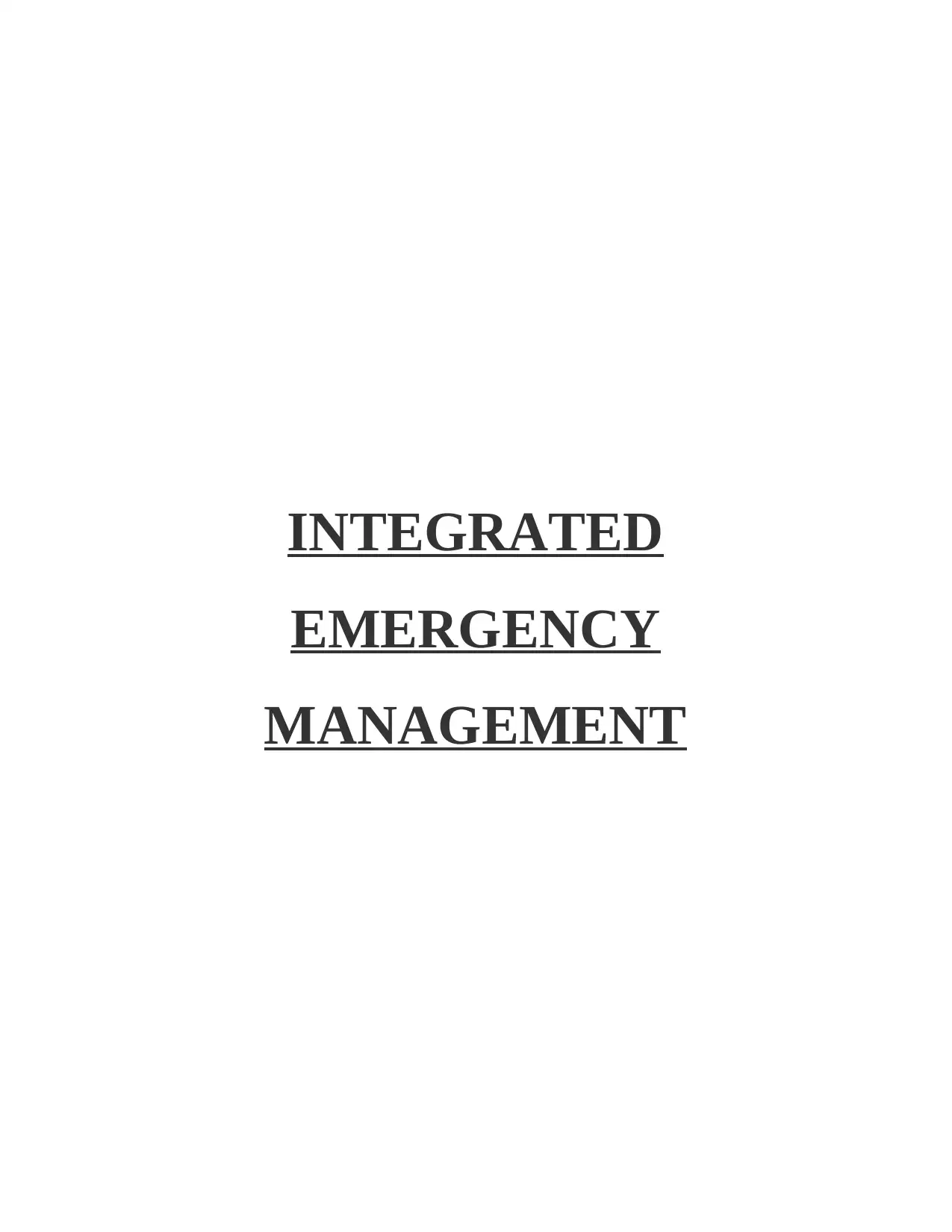
INTEGRATED
EMERGENCY
MANAGEMENT
EMERGENCY
MANAGEMENT
Paraphrase This Document
Need a fresh take? Get an instant paraphrase of this document with our AI Paraphraser
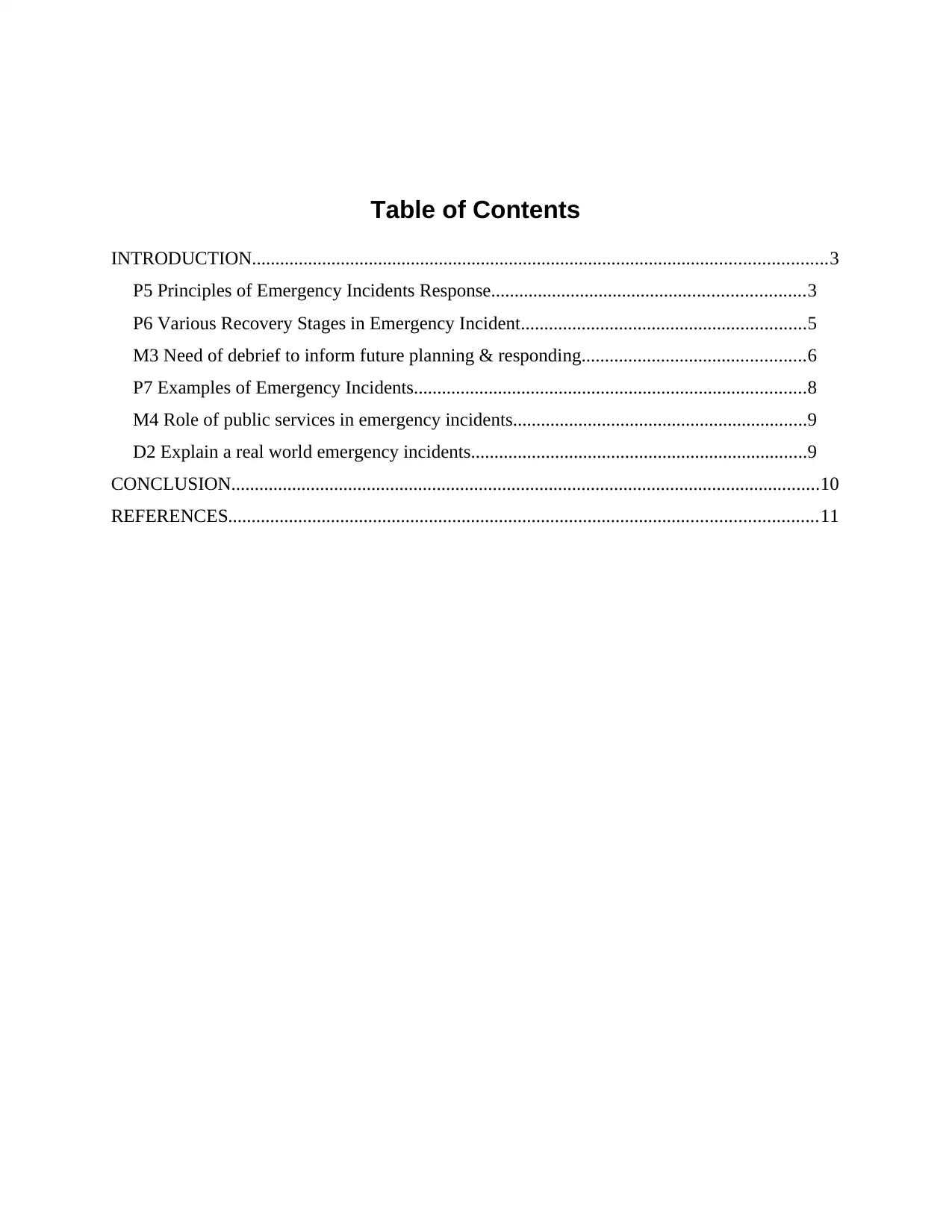
Table of Contents
INTRODUCTION...........................................................................................................................3
P5 Principles of Emergency Incidents Response...................................................................3
P6 Various Recovery Stages in Emergency Incident.............................................................5
M3 Need of debrief to inform future planning & responding................................................6
P7 Examples of Emergency Incidents....................................................................................8
M4 Role of public services in emergency incidents...............................................................9
D2 Explain a real world emergency incidents........................................................................9
CONCLUSION..............................................................................................................................10
REFERENCES..............................................................................................................................11
INTRODUCTION...........................................................................................................................3
P5 Principles of Emergency Incidents Response...................................................................3
P6 Various Recovery Stages in Emergency Incident.............................................................5
M3 Need of debrief to inform future planning & responding................................................6
P7 Examples of Emergency Incidents....................................................................................8
M4 Role of public services in emergency incidents...............................................................9
D2 Explain a real world emergency incidents........................................................................9
CONCLUSION..............................................................................................................................10
REFERENCES..............................................................................................................................11
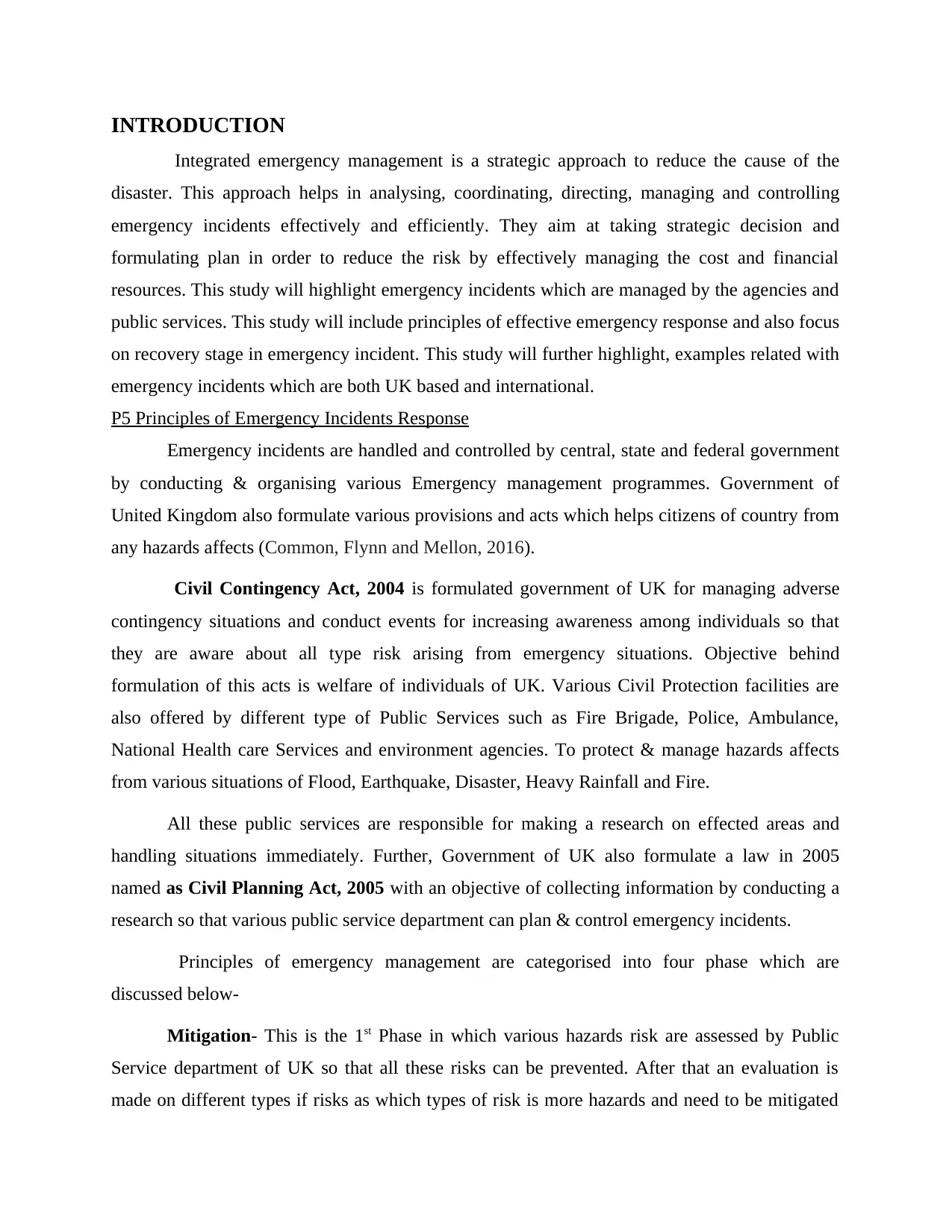
INTRODUCTION
Integrated emergency management is a strategic approach to reduce the cause of the
disaster. This approach helps in analysing, coordinating, directing, managing and controlling
emergency incidents effectively and efficiently. They aim at taking strategic decision and
formulating plan in order to reduce the risk by effectively managing the cost and financial
resources. This study will highlight emergency incidents which are managed by the agencies and
public services. This study will include principles of effective emergency response and also focus
on recovery stage in emergency incident. This study will further highlight, examples related with
emergency incidents which are both UK based and international.
P5 Principles of Emergency Incidents Response
Emergency incidents are handled and controlled by central, state and federal government
by conducting & organising various Emergency management programmes. Government of
United Kingdom also formulate various provisions and acts which helps citizens of country from
any hazards affects (Common, Flynn and Mellon, 2016).
Civil Contingency Act, 2004 is formulated government of UK for managing adverse
contingency situations and conduct events for increasing awareness among individuals so that
they are aware about all type risk arising from emergency situations. Objective behind
formulation of this acts is welfare of individuals of UK. Various Civil Protection facilities are
also offered by different type of Public Services such as Fire Brigade, Police, Ambulance,
National Health care Services and environment agencies. To protect & manage hazards affects
from various situations of Flood, Earthquake, Disaster, Heavy Rainfall and Fire.
All these public services are responsible for making a research on effected areas and
handling situations immediately. Further, Government of UK also formulate a law in 2005
named as Civil Planning Act, 2005 with an objective of collecting information by conducting a
research so that various public service department can plan & control emergency incidents.
Principles of emergency management are categorised into four phase which are
discussed below-
Mitigation- This is the 1st Phase in which various hazards risk are assessed by Public
Service department of UK so that all these risks can be prevented. After that an evaluation is
made on different types if risks as which types of risk is more hazards and need to be mitigated
Integrated emergency management is a strategic approach to reduce the cause of the
disaster. This approach helps in analysing, coordinating, directing, managing and controlling
emergency incidents effectively and efficiently. They aim at taking strategic decision and
formulating plan in order to reduce the risk by effectively managing the cost and financial
resources. This study will highlight emergency incidents which are managed by the agencies and
public services. This study will include principles of effective emergency response and also focus
on recovery stage in emergency incident. This study will further highlight, examples related with
emergency incidents which are both UK based and international.
P5 Principles of Emergency Incidents Response
Emergency incidents are handled and controlled by central, state and federal government
by conducting & organising various Emergency management programmes. Government of
United Kingdom also formulate various provisions and acts which helps citizens of country from
any hazards affects (Common, Flynn and Mellon, 2016).
Civil Contingency Act, 2004 is formulated government of UK for managing adverse
contingency situations and conduct events for increasing awareness among individuals so that
they are aware about all type risk arising from emergency situations. Objective behind
formulation of this acts is welfare of individuals of UK. Various Civil Protection facilities are
also offered by different type of Public Services such as Fire Brigade, Police, Ambulance,
National Health care Services and environment agencies. To protect & manage hazards affects
from various situations of Flood, Earthquake, Disaster, Heavy Rainfall and Fire.
All these public services are responsible for making a research on effected areas and
handling situations immediately. Further, Government of UK also formulate a law in 2005
named as Civil Planning Act, 2005 with an objective of collecting information by conducting a
research so that various public service department can plan & control emergency incidents.
Principles of emergency management are categorised into four phase which are
discussed below-
Mitigation- This is the 1st Phase in which various hazards risk are assessed by Public
Service department of UK so that all these risks can be prevented. After that an evaluation is
made on different types if risks as which types of risk is more hazards and need to be mitigated
⊘ This is a preview!⊘
Do you want full access?
Subscribe today to unlock all pages.

Trusted by 1+ million students worldwide
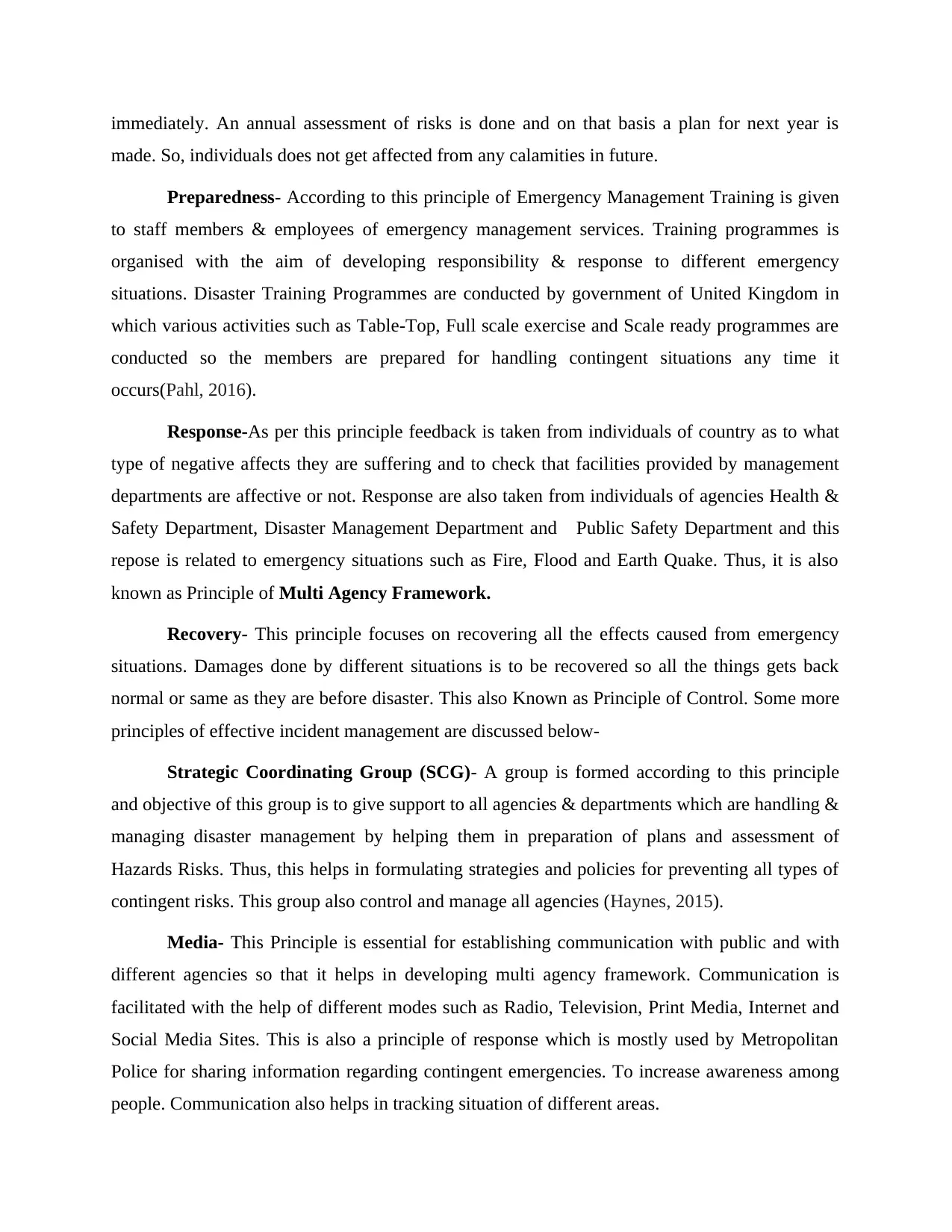
immediately. An annual assessment of risks is done and on that basis a plan for next year is
made. So, individuals does not get affected from any calamities in future.
Preparedness- According to this principle of Emergency Management Training is given
to staff members & employees of emergency management services. Training programmes is
organised with the aim of developing responsibility & response to different emergency
situations. Disaster Training Programmes are conducted by government of United Kingdom in
which various activities such as Table-Top, Full scale exercise and Scale ready programmes are
conducted so the members are prepared for handling contingent situations any time it
occurs(Pahl, 2016).
Response-As per this principle feedback is taken from individuals of country as to what
type of negative affects they are suffering and to check that facilities provided by management
departments are affective or not. Response are also taken from individuals of agencies Health &
Safety Department, Disaster Management Department and Public Safety Department and this
repose is related to emergency situations such as Fire, Flood and Earth Quake. Thus, it is also
known as Principle of Multi Agency Framework.
Recovery- This principle focuses on recovering all the effects caused from emergency
situations. Damages done by different situations is to be recovered so all the things gets back
normal or same as they are before disaster. This also Known as Principle of Control. Some more
principles of effective incident management are discussed below-
Strategic Coordinating Group (SCG)- A group is formed according to this principle
and objective of this group is to give support to all agencies & departments which are handling &
managing disaster management by helping them in preparation of plans and assessment of
Hazards Risks. Thus, this helps in formulating strategies and policies for preventing all types of
contingent risks. This group also control and manage all agencies (Haynes, 2015).
Media- This Principle is essential for establishing communication with public and with
different agencies so that it helps in developing multi agency framework. Communication is
facilitated with the help of different modes such as Radio, Television, Print Media, Internet and
Social Media Sites. This is also a principle of response which is mostly used by Metropolitan
Police for sharing information regarding contingent emergencies. To increase awareness among
people. Communication also helps in tracking situation of different areas.
made. So, individuals does not get affected from any calamities in future.
Preparedness- According to this principle of Emergency Management Training is given
to staff members & employees of emergency management services. Training programmes is
organised with the aim of developing responsibility & response to different emergency
situations. Disaster Training Programmes are conducted by government of United Kingdom in
which various activities such as Table-Top, Full scale exercise and Scale ready programmes are
conducted so the members are prepared for handling contingent situations any time it
occurs(Pahl, 2016).
Response-As per this principle feedback is taken from individuals of country as to what
type of negative affects they are suffering and to check that facilities provided by management
departments are affective or not. Response are also taken from individuals of agencies Health &
Safety Department, Disaster Management Department and Public Safety Department and this
repose is related to emergency situations such as Fire, Flood and Earth Quake. Thus, it is also
known as Principle of Multi Agency Framework.
Recovery- This principle focuses on recovering all the effects caused from emergency
situations. Damages done by different situations is to be recovered so all the things gets back
normal or same as they are before disaster. This also Known as Principle of Control. Some more
principles of effective incident management are discussed below-
Strategic Coordinating Group (SCG)- A group is formed according to this principle
and objective of this group is to give support to all agencies & departments which are handling &
managing disaster management by helping them in preparation of plans and assessment of
Hazards Risks. Thus, this helps in formulating strategies and policies for preventing all types of
contingent risks. This group also control and manage all agencies (Haynes, 2015).
Media- This Principle is essential for establishing communication with public and with
different agencies so that it helps in developing multi agency framework. Communication is
facilitated with the help of different modes such as Radio, Television, Print Media, Internet and
Social Media Sites. This is also a principle of response which is mostly used by Metropolitan
Police for sharing information regarding contingent emergencies. To increase awareness among
people. Communication also helps in tracking situation of different areas.
Paraphrase This Document
Need a fresh take? Get an instant paraphrase of this document with our AI Paraphraser
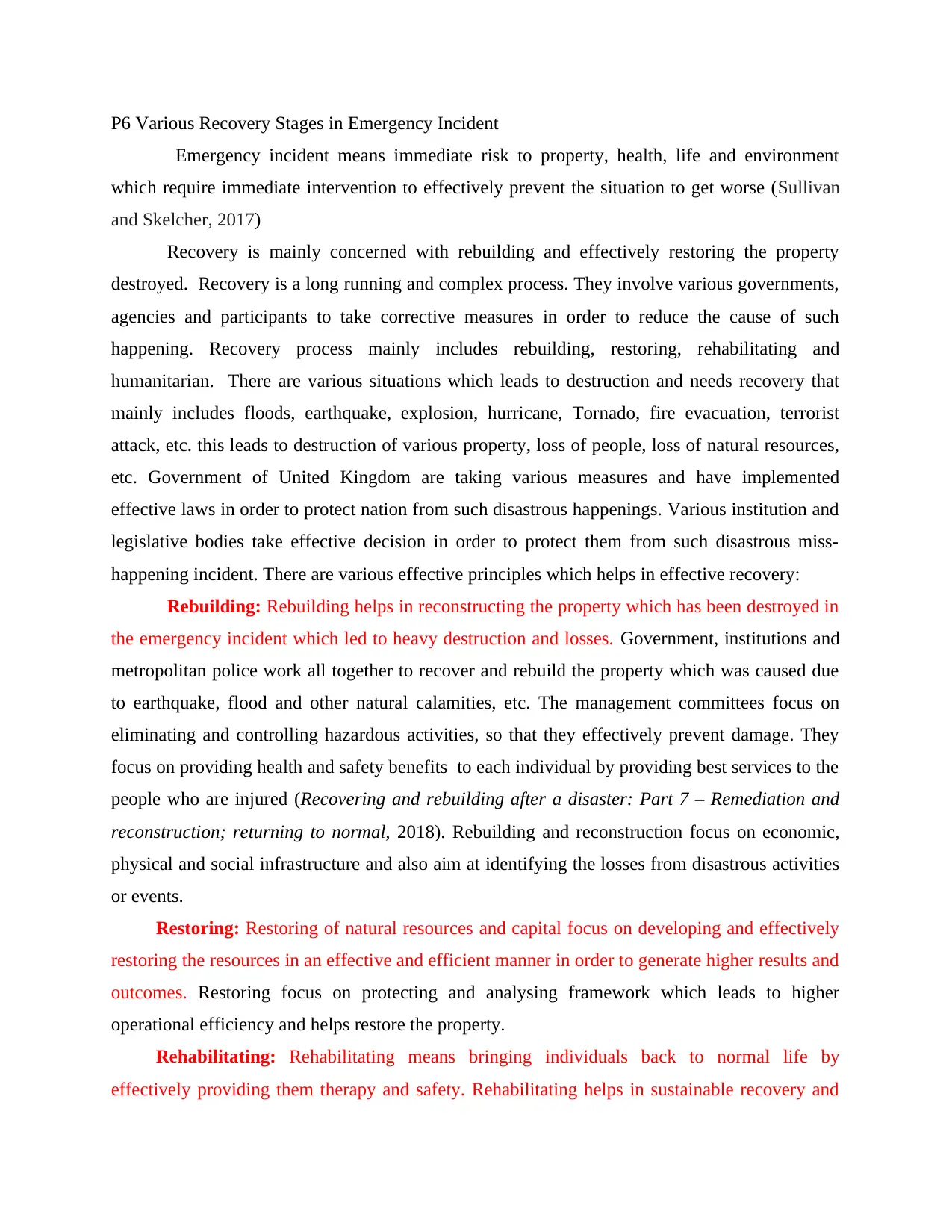
P6 Various Recovery Stages in Emergency Incident
Emergency incident means immediate risk to property, health, life and environment
which require immediate intervention to effectively prevent the situation to get worse (Sullivan
and Skelcher, 2017)
Recovery is mainly concerned with rebuilding and effectively restoring the property
destroyed. Recovery is a long running and complex process. They involve various governments,
agencies and participants to take corrective measures in order to reduce the cause of such
happening. Recovery process mainly includes rebuilding, restoring, rehabilitating and
humanitarian. There are various situations which leads to destruction and needs recovery that
mainly includes floods, earthquake, explosion, hurricane, Tornado, fire evacuation, terrorist
attack, etc. this leads to destruction of various property, loss of people, loss of natural resources,
etc. Government of United Kingdom are taking various measures and have implemented
effective laws in order to protect nation from such disastrous happenings. Various institution and
legislative bodies take effective decision in order to protect them from such disastrous miss-
happening incident. There are various effective principles which helps in effective recovery:
Rebuilding: Rebuilding helps in reconstructing the property which has been destroyed in
the emergency incident which led to heavy destruction and losses. Government, institutions and
metropolitan police work all together to recover and rebuild the property which was caused due
to earthquake, flood and other natural calamities, etc. The management committees focus on
eliminating and controlling hazardous activities, so that they effectively prevent damage. They
focus on providing health and safety benefits to each individual by providing best services to the
people who are injured (Recovering and rebuilding after a disaster: Part 7 – Remediation and
reconstruction; returning to normal, 2018). Rebuilding and reconstruction focus on economic,
physical and social infrastructure and also aim at identifying the losses from disastrous activities
or events.
Restoring: Restoring of natural resources and capital focus on developing and effectively
restoring the resources in an effective and efficient manner in order to generate higher results and
outcomes. Restoring focus on protecting and analysing framework which leads to higher
operational efficiency and helps restore the property.
Rehabilitating: Rehabilitating means bringing individuals back to normal life by
effectively providing them therapy and safety. Rehabilitating helps in sustainable recovery and
Emergency incident means immediate risk to property, health, life and environment
which require immediate intervention to effectively prevent the situation to get worse (Sullivan
and Skelcher, 2017)
Recovery is mainly concerned with rebuilding and effectively restoring the property
destroyed. Recovery is a long running and complex process. They involve various governments,
agencies and participants to take corrective measures in order to reduce the cause of such
happening. Recovery process mainly includes rebuilding, restoring, rehabilitating and
humanitarian. There are various situations which leads to destruction and needs recovery that
mainly includes floods, earthquake, explosion, hurricane, Tornado, fire evacuation, terrorist
attack, etc. this leads to destruction of various property, loss of people, loss of natural resources,
etc. Government of United Kingdom are taking various measures and have implemented
effective laws in order to protect nation from such disastrous happenings. Various institution and
legislative bodies take effective decision in order to protect them from such disastrous miss-
happening incident. There are various effective principles which helps in effective recovery:
Rebuilding: Rebuilding helps in reconstructing the property which has been destroyed in
the emergency incident which led to heavy destruction and losses. Government, institutions and
metropolitan police work all together to recover and rebuild the property which was caused due
to earthquake, flood and other natural calamities, etc. The management committees focus on
eliminating and controlling hazardous activities, so that they effectively prevent damage. They
focus on providing health and safety benefits to each individual by providing best services to the
people who are injured (Recovering and rebuilding after a disaster: Part 7 – Remediation and
reconstruction; returning to normal, 2018). Rebuilding and reconstruction focus on economic,
physical and social infrastructure and also aim at identifying the losses from disastrous activities
or events.
Restoring: Restoring of natural resources and capital focus on developing and effectively
restoring the resources in an effective and efficient manner in order to generate higher results and
outcomes. Restoring focus on protecting and analysing framework which leads to higher
operational efficiency and helps restore the property.
Rehabilitating: Rehabilitating means bringing individuals back to normal life by
effectively providing them therapy and safety. Rehabilitating helps in sustainable recovery and
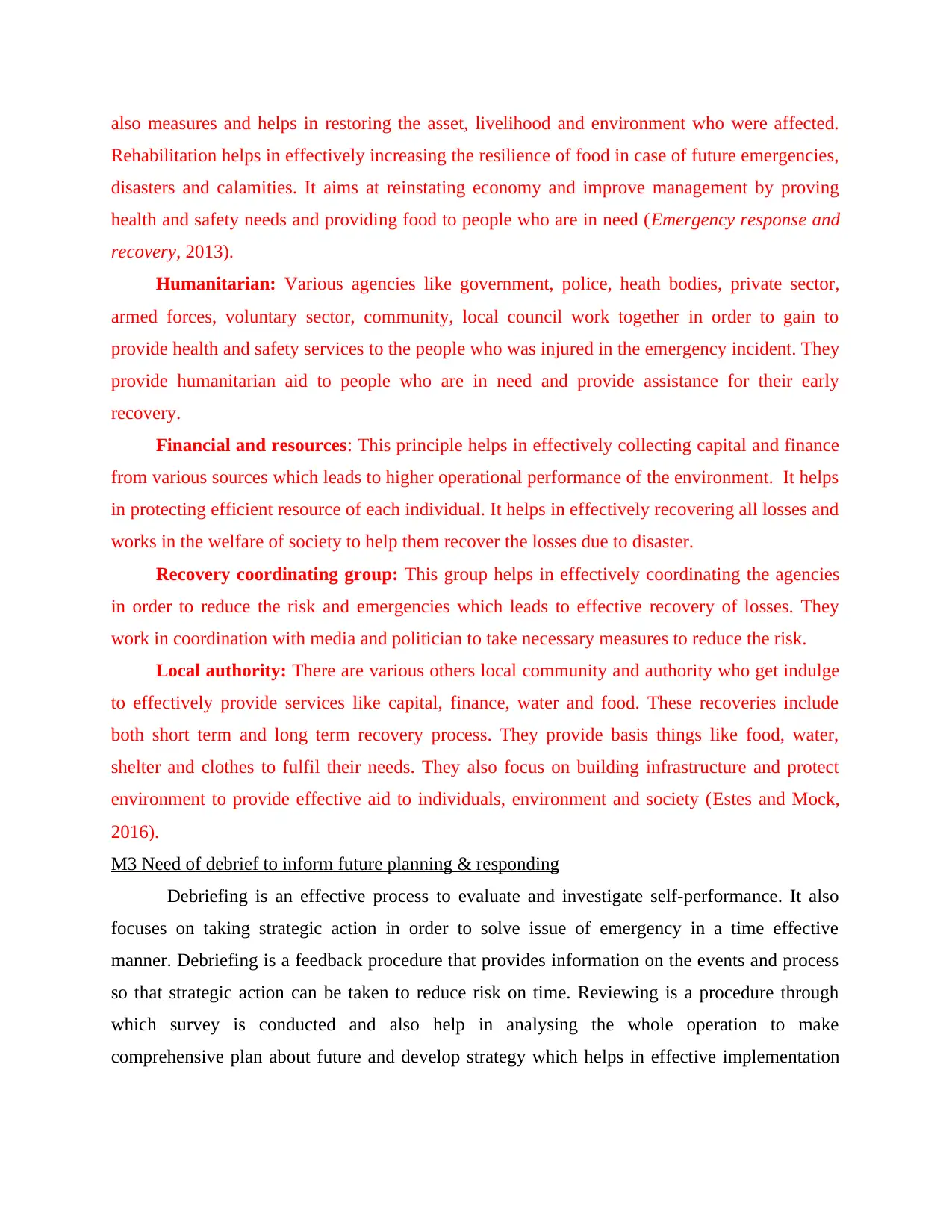
also measures and helps in restoring the asset, livelihood and environment who were affected.
Rehabilitation helps in effectively increasing the resilience of food in case of future emergencies,
disasters and calamities. It aims at reinstating economy and improve management by proving
health and safety needs and providing food to people who are in need (Emergency response and
recovery, 2013).
Humanitarian: Various agencies like government, police, heath bodies, private sector,
armed forces, voluntary sector, community, local council work together in order to gain to
provide health and safety services to the people who was injured in the emergency incident. They
provide humanitarian aid to people who are in need and provide assistance for their early
recovery.
Financial and resources: This principle helps in effectively collecting capital and finance
from various sources which leads to higher operational performance of the environment. It helps
in protecting efficient resource of each individual. It helps in effectively recovering all losses and
works in the welfare of society to help them recover the losses due to disaster.
Recovery coordinating group: This group helps in effectively coordinating the agencies
in order to reduce the risk and emergencies which leads to effective recovery of losses. They
work in coordination with media and politician to take necessary measures to reduce the risk.
Local authority: There are various others local community and authority who get indulge
to effectively provide services like capital, finance, water and food. These recoveries include
both short term and long term recovery process. They provide basis things like food, water,
shelter and clothes to fulfil their needs. They also focus on building infrastructure and protect
environment to provide effective aid to individuals, environment and society (Estes and Mock,
2016).
M3 Need of debrief to inform future planning & responding
Debriefing is an effective process to evaluate and investigate self-performance. It also
focuses on taking strategic action in order to solve issue of emergency in a time effective
manner. Debriefing is a feedback procedure that provides information on the events and process
so that strategic action can be taken to reduce risk on time. Reviewing is a procedure through
which survey is conducted and also help in analysing the whole operation to make
comprehensive plan about future and develop strategy which helps in effective implementation
Rehabilitation helps in effectively increasing the resilience of food in case of future emergencies,
disasters and calamities. It aims at reinstating economy and improve management by proving
health and safety needs and providing food to people who are in need (Emergency response and
recovery, 2013).
Humanitarian: Various agencies like government, police, heath bodies, private sector,
armed forces, voluntary sector, community, local council work together in order to gain to
provide health and safety services to the people who was injured in the emergency incident. They
provide humanitarian aid to people who are in need and provide assistance for their early
recovery.
Financial and resources: This principle helps in effectively collecting capital and finance
from various sources which leads to higher operational performance of the environment. It helps
in protecting efficient resource of each individual. It helps in effectively recovering all losses and
works in the welfare of society to help them recover the losses due to disaster.
Recovery coordinating group: This group helps in effectively coordinating the agencies
in order to reduce the risk and emergencies which leads to effective recovery of losses. They
work in coordination with media and politician to take necessary measures to reduce the risk.
Local authority: There are various others local community and authority who get indulge
to effectively provide services like capital, finance, water and food. These recoveries include
both short term and long term recovery process. They provide basis things like food, water,
shelter and clothes to fulfil their needs. They also focus on building infrastructure and protect
environment to provide effective aid to individuals, environment and society (Estes and Mock,
2016).
M3 Need of debrief to inform future planning & responding
Debriefing is an effective process to evaluate and investigate self-performance. It also
focuses on taking strategic action in order to solve issue of emergency in a time effective
manner. Debriefing is a feedback procedure that provides information on the events and process
so that strategic action can be taken to reduce risk on time. Reviewing is a procedure through
which survey is conducted and also help in analysing the whole operation to make
comprehensive plan about future and develop strategy which helps in effective implementation
⊘ This is a preview!⊘
Do you want full access?
Subscribe today to unlock all pages.

Trusted by 1+ million students worldwide
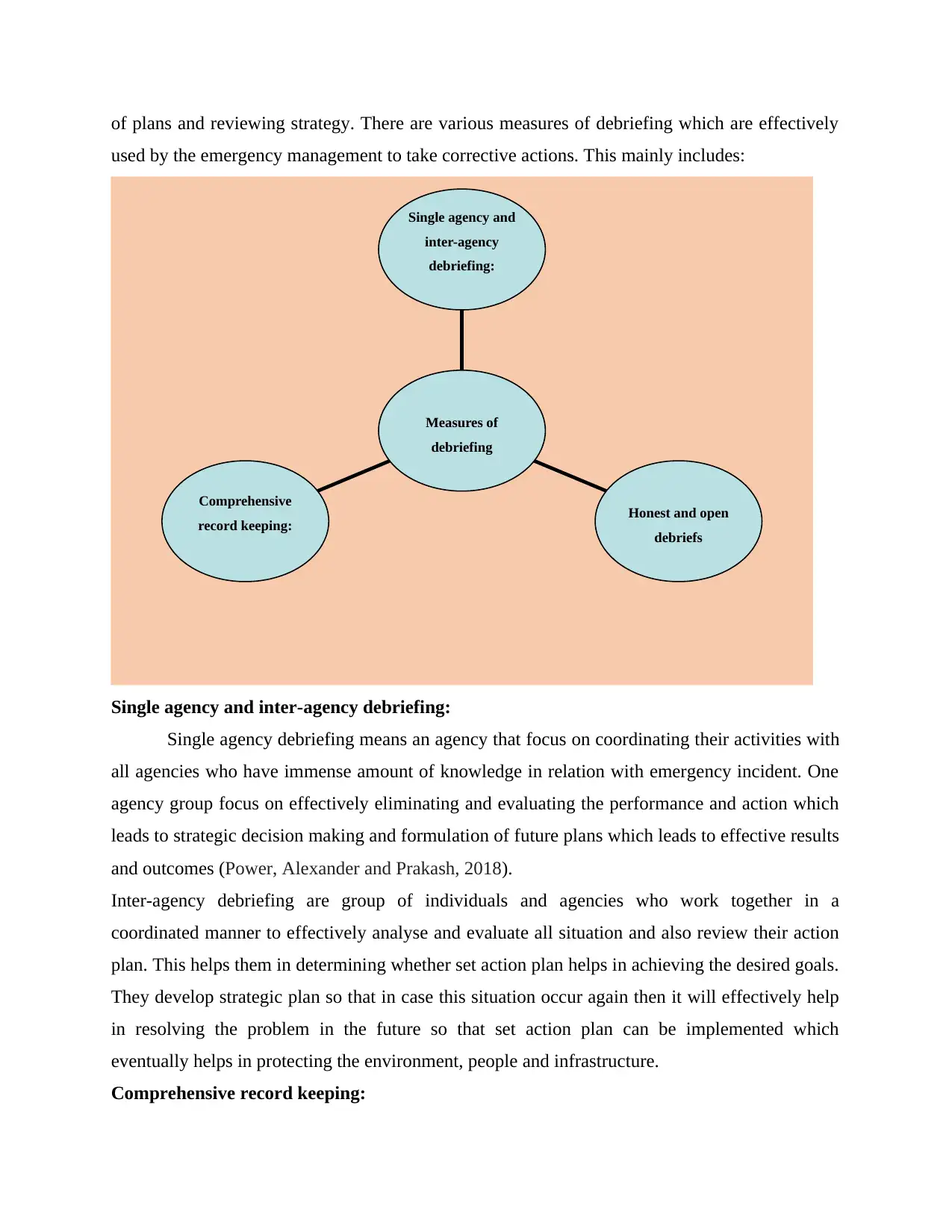
of plans and reviewing strategy. There are various measures of debriefing which are effectively
used by the emergency management to take corrective actions. This mainly includes:
Single agency and inter-agency debriefing:
Single agency debriefing means an agency that focus on coordinating their activities with
all agencies who have immense amount of knowledge in relation with emergency incident. One
agency group focus on effectively eliminating and evaluating the performance and action which
leads to strategic decision making and formulation of future plans which leads to effective results
and outcomes (Power, Alexander and Prakash, 2018).
Inter-agency debriefing are group of individuals and agencies who work together in a
coordinated manner to effectively analyse and evaluate all situation and also review their action
plan. This helps them in determining whether set action plan helps in achieving the desired goals.
They develop strategic plan so that in case this situation occur again then it will effectively help
in resolving the problem in the future so that set action plan can be implemented which
eventually helps in protecting the environment, people and infrastructure.
Comprehensive record keeping:
Comprehensive
record keeping: Honest and open
debriefs
Single agency and
inter-agency
debriefing:
Measures of
debriefing
used by the emergency management to take corrective actions. This mainly includes:
Single agency and inter-agency debriefing:
Single agency debriefing means an agency that focus on coordinating their activities with
all agencies who have immense amount of knowledge in relation with emergency incident. One
agency group focus on effectively eliminating and evaluating the performance and action which
leads to strategic decision making and formulation of future plans which leads to effective results
and outcomes (Power, Alexander and Prakash, 2018).
Inter-agency debriefing are group of individuals and agencies who work together in a
coordinated manner to effectively analyse and evaluate all situation and also review their action
plan. This helps them in determining whether set action plan helps in achieving the desired goals.
They develop strategic plan so that in case this situation occur again then it will effectively help
in resolving the problem in the future so that set action plan can be implemented which
eventually helps in protecting the environment, people and infrastructure.
Comprehensive record keeping:
Comprehensive
record keeping: Honest and open
debriefs
Single agency and
inter-agency
debriefing:
Measures of
debriefing
Paraphrase This Document
Need a fresh take? Get an instant paraphrase of this document with our AI Paraphraser
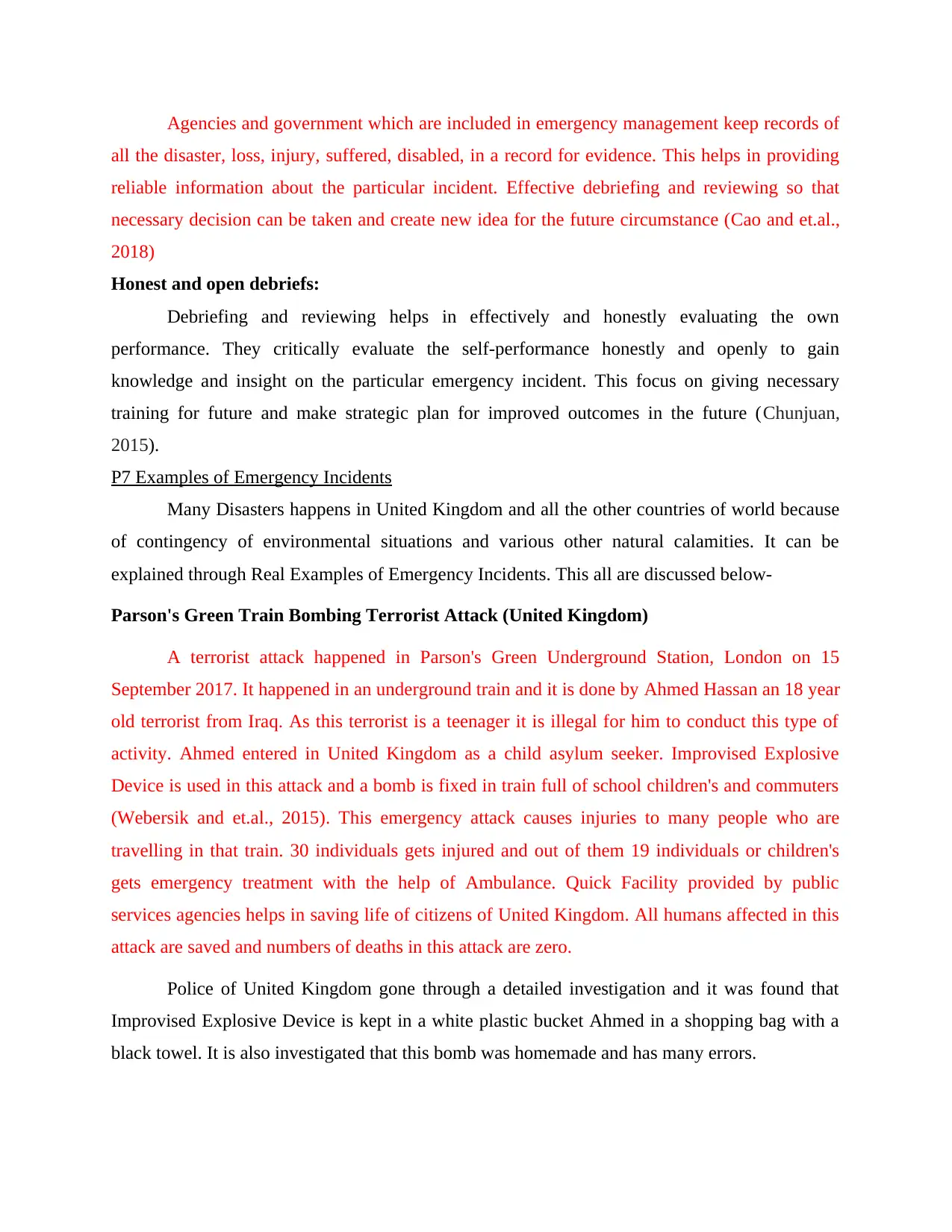
Agencies and government which are included in emergency management keep records of
all the disaster, loss, injury, suffered, disabled, in a record for evidence. This helps in providing
reliable information about the particular incident. Effective debriefing and reviewing so that
necessary decision can be taken and create new idea for the future circumstance (Cao and et.al.,
2018)
Honest and open debriefs:
Debriefing and reviewing helps in effectively and honestly evaluating the own
performance. They critically evaluate the self-performance honestly and openly to gain
knowledge and insight on the particular emergency incident. This focus on giving necessary
training for future and make strategic plan for improved outcomes in the future (Chunjuan,
2015).
P7 Examples of Emergency Incidents
Many Disasters happens in United Kingdom and all the other countries of world because
of contingency of environmental situations and various other natural calamities. It can be
explained through Real Examples of Emergency Incidents. This all are discussed below-
Parson's Green Train Bombing Terrorist Attack (United Kingdom)
A terrorist attack happened in Parson's Green Underground Station, London on 15
September 2017. It happened in an underground train and it is done by Ahmed Hassan an 18 year
old terrorist from Iraq. As this terrorist is a teenager it is illegal for him to conduct this type of
activity. Ahmed entered in United Kingdom as a child asylum seeker. Improvised Explosive
Device is used in this attack and a bomb is fixed in train full of school children's and commuters
(Webersik and et.al., 2015). This emergency attack causes injuries to many people who are
travelling in that train. 30 individuals gets injured and out of them 19 individuals or children's
gets emergency treatment with the help of Ambulance. Quick Facility provided by public
services agencies helps in saving life of citizens of United Kingdom. All humans affected in this
attack are saved and numbers of deaths in this attack are zero.
Police of United Kingdom gone through a detailed investigation and it was found that
Improvised Explosive Device is kept in a white plastic bucket Ahmed in a shopping bag with a
black towel. It is also investigated that this bomb was homemade and has many errors.
all the disaster, loss, injury, suffered, disabled, in a record for evidence. This helps in providing
reliable information about the particular incident. Effective debriefing and reviewing so that
necessary decision can be taken and create new idea for the future circumstance (Cao and et.al.,
2018)
Honest and open debriefs:
Debriefing and reviewing helps in effectively and honestly evaluating the own
performance. They critically evaluate the self-performance honestly and openly to gain
knowledge and insight on the particular emergency incident. This focus on giving necessary
training for future and make strategic plan for improved outcomes in the future (Chunjuan,
2015).
P7 Examples of Emergency Incidents
Many Disasters happens in United Kingdom and all the other countries of world because
of contingency of environmental situations and various other natural calamities. It can be
explained through Real Examples of Emergency Incidents. This all are discussed below-
Parson's Green Train Bombing Terrorist Attack (United Kingdom)
A terrorist attack happened in Parson's Green Underground Station, London on 15
September 2017. It happened in an underground train and it is done by Ahmed Hassan an 18 year
old terrorist from Iraq. As this terrorist is a teenager it is illegal for him to conduct this type of
activity. Ahmed entered in United Kingdom as a child asylum seeker. Improvised Explosive
Device is used in this attack and a bomb is fixed in train full of school children's and commuters
(Webersik and et.al., 2015). This emergency attack causes injuries to many people who are
travelling in that train. 30 individuals gets injured and out of them 19 individuals or children's
gets emergency treatment with the help of Ambulance. Quick Facility provided by public
services agencies helps in saving life of citizens of United Kingdom. All humans affected in this
attack are saved and numbers of deaths in this attack are zero.
Police of United Kingdom gone through a detailed investigation and it was found that
Improvised Explosive Device is kept in a white plastic bucket Ahmed in a shopping bag with a
black towel. It is also investigated that this bomb was homemade and has many errors.
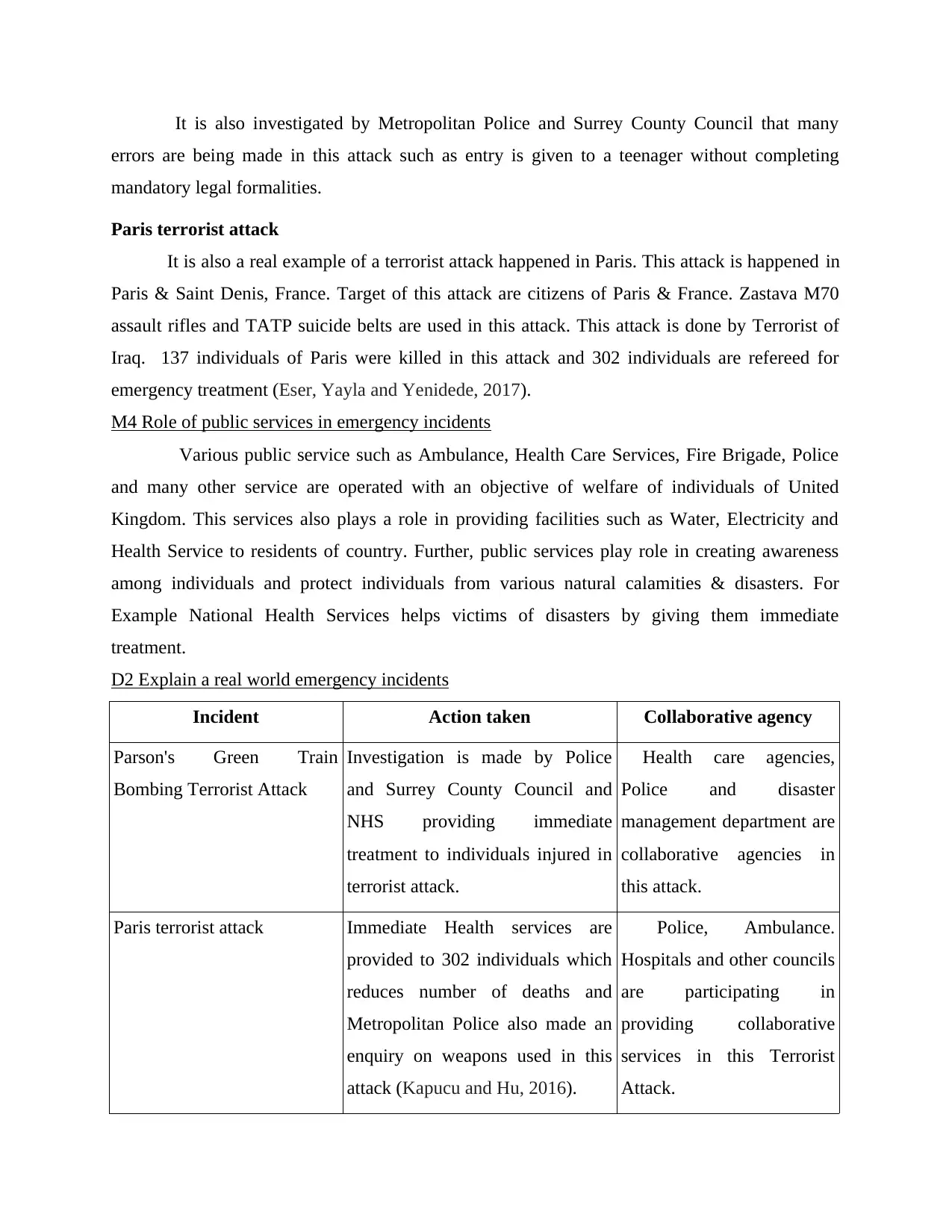
It is also investigated by Metropolitan Police and Surrey County Council that many
errors are being made in this attack such as entry is given to a teenager without completing
mandatory legal formalities.
Paris terrorist attack
It is also a real example of a terrorist attack happened in Paris. This attack is happened in
Paris & Saint Denis, France. Target of this attack are citizens of Paris & France. Zastava M70
assault rifles and TATP suicide belts are used in this attack. This attack is done by Terrorist of
Iraq. 137 individuals of Paris were killed in this attack and 302 individuals are refereed for
emergency treatment (Eser, Yayla and Yenidede, 2017).
M4 Role of public services in emergency incidents
Various public service such as Ambulance, Health Care Services, Fire Brigade, Police
and many other service are operated with an objective of welfare of individuals of United
Kingdom. This services also plays a role in providing facilities such as Water, Electricity and
Health Service to residents of country. Further, public services play role in creating awareness
among individuals and protect individuals from various natural calamities & disasters. For
Example National Health Services helps victims of disasters by giving them immediate
treatment.
D2 Explain a real world emergency incidents
Incident Action taken Collaborative agency
Parson's Green Train
Bombing Terrorist Attack
Investigation is made by Police
and Surrey County Council and
NHS providing immediate
treatment to individuals injured in
terrorist attack.
Health care agencies,
Police and disaster
management department are
collaborative agencies in
this attack.
Paris terrorist attack Immediate Health services are
provided to 302 individuals which
reduces number of deaths and
Metropolitan Police also made an
enquiry on weapons used in this
attack (Kapucu and Hu, 2016).
Police, Ambulance.
Hospitals and other councils
are participating in
providing collaborative
services in this Terrorist
Attack.
errors are being made in this attack such as entry is given to a teenager without completing
mandatory legal formalities.
Paris terrorist attack
It is also a real example of a terrorist attack happened in Paris. This attack is happened in
Paris & Saint Denis, France. Target of this attack are citizens of Paris & France. Zastava M70
assault rifles and TATP suicide belts are used in this attack. This attack is done by Terrorist of
Iraq. 137 individuals of Paris were killed in this attack and 302 individuals are refereed for
emergency treatment (Eser, Yayla and Yenidede, 2017).
M4 Role of public services in emergency incidents
Various public service such as Ambulance, Health Care Services, Fire Brigade, Police
and many other service are operated with an objective of welfare of individuals of United
Kingdom. This services also plays a role in providing facilities such as Water, Electricity and
Health Service to residents of country. Further, public services play role in creating awareness
among individuals and protect individuals from various natural calamities & disasters. For
Example National Health Services helps victims of disasters by giving them immediate
treatment.
D2 Explain a real world emergency incidents
Incident Action taken Collaborative agency
Parson's Green Train
Bombing Terrorist Attack
Investigation is made by Police
and Surrey County Council and
NHS providing immediate
treatment to individuals injured in
terrorist attack.
Health care agencies,
Police and disaster
management department are
collaborative agencies in
this attack.
Paris terrorist attack Immediate Health services are
provided to 302 individuals which
reduces number of deaths and
Metropolitan Police also made an
enquiry on weapons used in this
attack (Kapucu and Hu, 2016).
Police, Ambulance.
Hospitals and other councils
are participating in
providing collaborative
services in this Terrorist
Attack.
⊘ This is a preview!⊘
Do you want full access?
Subscribe today to unlock all pages.

Trusted by 1+ million students worldwide
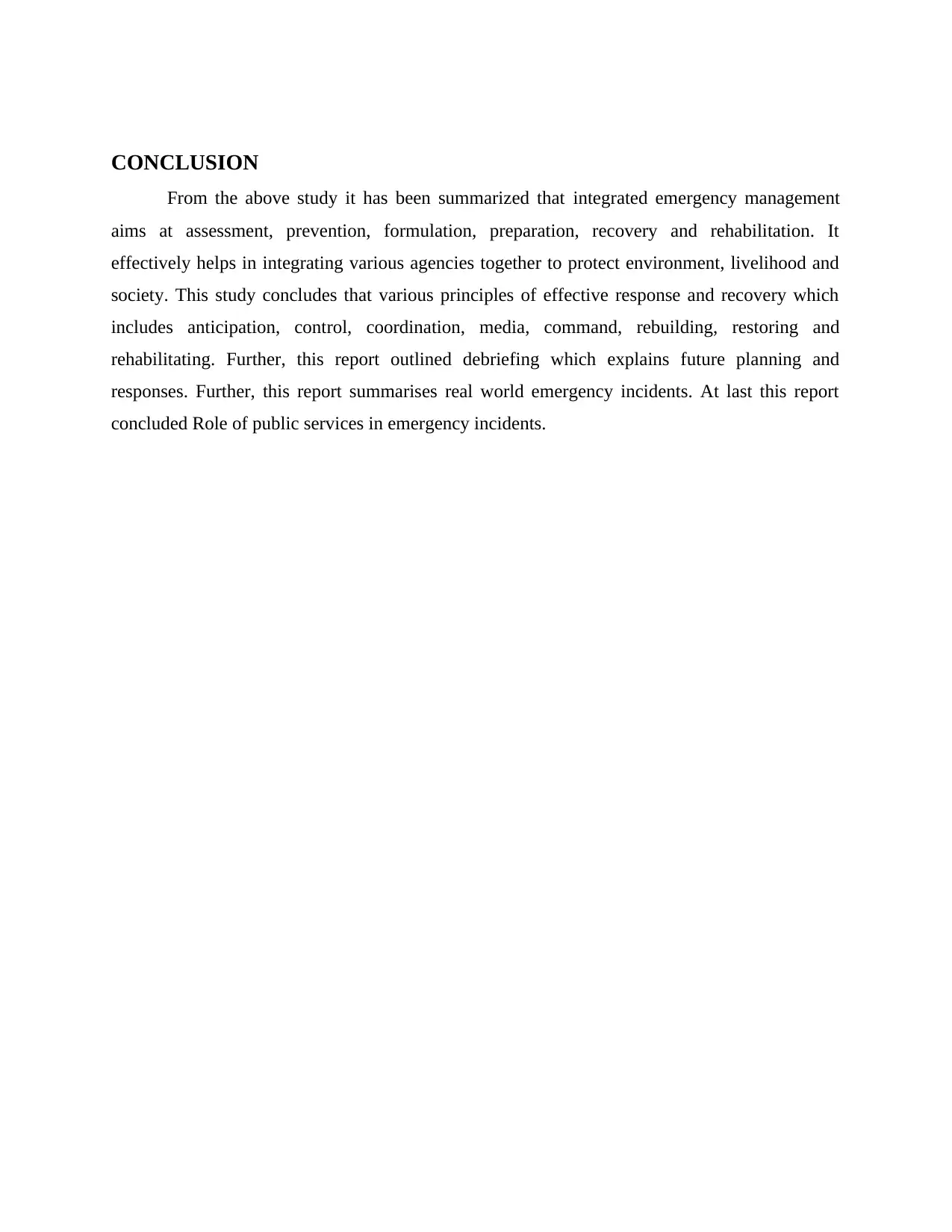
CONCLUSION
From the above study it has been summarized that integrated emergency management
aims at assessment, prevention, formulation, preparation, recovery and rehabilitation. It
effectively helps in integrating various agencies together to protect environment, livelihood and
society. This study concludes that various principles of effective response and recovery which
includes anticipation, control, coordination, media, command, rebuilding, restoring and
rehabilitating. Further, this report outlined debriefing which explains future planning and
responses. Further, this report summarises real world emergency incidents. At last this report
concluded Role of public services in emergency incidents.
From the above study it has been summarized that integrated emergency management
aims at assessment, prevention, formulation, preparation, recovery and rehabilitation. It
effectively helps in integrating various agencies together to protect environment, livelihood and
society. This study concludes that various principles of effective response and recovery which
includes anticipation, control, coordination, media, command, rebuilding, restoring and
rehabilitating. Further, this report outlined debriefing which explains future planning and
responses. Further, this report summarises real world emergency incidents. At last this report
concluded Role of public services in emergency incidents.
Paraphrase This Document
Need a fresh take? Get an instant paraphrase of this document with our AI Paraphraser
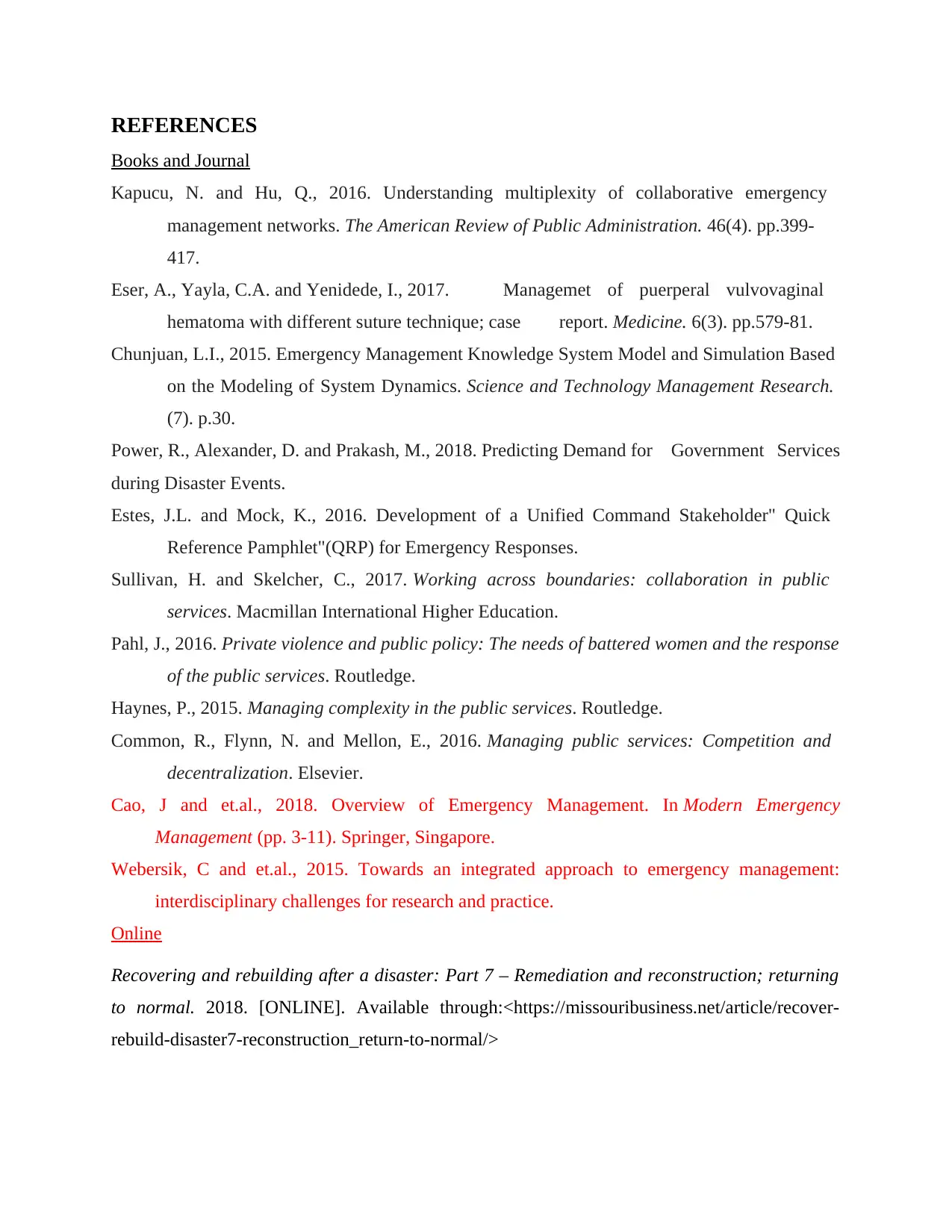
REFERENCES
Books and Journal
Kapucu, N. and Hu, Q., 2016. Understanding multiplexity of collaborative emergency
management networks. The American Review of Public Administration. 46(4). pp.399-
417.
Eser, A., Yayla, C.A. and Yenidede, I., 2017. Managemet of puerperal vulvovaginal
hematoma with different suture technique; case report. Medicine. 6(3). pp.579-81.
Chunjuan, L.I., 2015. Emergency Management Knowledge System Model and Simulation Based
on the Modeling of System Dynamics. Science and Technology Management Research.
(7). p.30.
Power, R., Alexander, D. and Prakash, M., 2018. Predicting Demand for Government Services
during Disaster Events.
Estes, J.L. and Mock, K., 2016. Development of a Unified Command Stakeholder" Quick
Reference Pamphlet"(QRP) for Emergency Responses.
Sullivan, H. and Skelcher, C., 2017. Working across boundaries: collaboration in public
services. Macmillan International Higher Education.
Pahl, J., 2016. Private violence and public policy: The needs of battered women and the response
of the public services. Routledge.
Haynes, P., 2015. Managing complexity in the public services. Routledge.
Common, R., Flynn, N. and Mellon, E., 2016. Managing public services: Competition and
decentralization. Elsevier.
Cao, J and et.al., 2018. Overview of Emergency Management. In Modern Emergency
Management (pp. 3-11). Springer, Singapore.
Webersik, C and et.al., 2015. Towards an integrated approach to emergency management:
interdisciplinary challenges for research and practice.
Online
Recovering and rebuilding after a disaster: Part 7 – Remediation and reconstruction; returning
to normal. 2018. [ONLINE]. Available through:<https://missouribusiness.net/article/recover-
rebuild-disaster7-reconstruction_return-to-normal/>
Books and Journal
Kapucu, N. and Hu, Q., 2016. Understanding multiplexity of collaborative emergency
management networks. The American Review of Public Administration. 46(4). pp.399-
417.
Eser, A., Yayla, C.A. and Yenidede, I., 2017. Managemet of puerperal vulvovaginal
hematoma with different suture technique; case report. Medicine. 6(3). pp.579-81.
Chunjuan, L.I., 2015. Emergency Management Knowledge System Model and Simulation Based
on the Modeling of System Dynamics. Science and Technology Management Research.
(7). p.30.
Power, R., Alexander, D. and Prakash, M., 2018. Predicting Demand for Government Services
during Disaster Events.
Estes, J.L. and Mock, K., 2016. Development of a Unified Command Stakeholder" Quick
Reference Pamphlet"(QRP) for Emergency Responses.
Sullivan, H. and Skelcher, C., 2017. Working across boundaries: collaboration in public
services. Macmillan International Higher Education.
Pahl, J., 2016. Private violence and public policy: The needs of battered women and the response
of the public services. Routledge.
Haynes, P., 2015. Managing complexity in the public services. Routledge.
Common, R., Flynn, N. and Mellon, E., 2016. Managing public services: Competition and
decentralization. Elsevier.
Cao, J and et.al., 2018. Overview of Emergency Management. In Modern Emergency
Management (pp. 3-11). Springer, Singapore.
Webersik, C and et.al., 2015. Towards an integrated approach to emergency management:
interdisciplinary challenges for research and practice.
Online
Recovering and rebuilding after a disaster: Part 7 – Remediation and reconstruction; returning
to normal. 2018. [ONLINE]. Available through:<https://missouribusiness.net/article/recover-
rebuild-disaster7-reconstruction_return-to-normal/>

Emergency response and recovery. 2013. [ONLINE]. Available
through:<https://www.gov.uk/guidance/emergency-response-and-recovery>
through:<https://www.gov.uk/guidance/emergency-response-and-recovery>
⊘ This is a preview!⊘
Do you want full access?
Subscribe today to unlock all pages.

Trusted by 1+ million students worldwide
1 out of 12
Related Documents
Your All-in-One AI-Powered Toolkit for Academic Success.
+13062052269
info@desklib.com
Available 24*7 on WhatsApp / Email
![[object Object]](/_next/static/media/star-bottom.7253800d.svg)
Unlock your academic potential
Copyright © 2020–2025 A2Z Services. All Rights Reserved. Developed and managed by ZUCOL.




